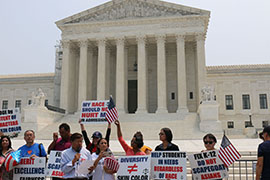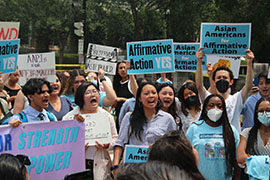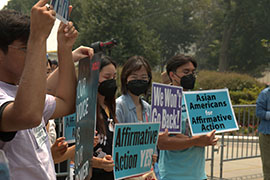- Slug: BC-CNS-Race-based Reversal,1000 words.
- 4 photos, video story available (thumbnails, captions below).
By Lillie Boudreaux
Cronkite News
WASHINGTON – A divided Supreme Court said Thursday that race-based admissions policies at Harvard and the University of North Carolina are unconstitutional violations of the 14th Amendment’s equal protection clause.
The policies may have had commendable goals, Chief Justice John Roberts wrote for the 6-3 majority, but “eliminating racial discrimination means eliminating all of it.” He said college applicants “must be treated based on … experiences as an individual – not on the basis of race.”
But Justice Sonia Sotomayor, in one of two dissents, said the ruling imposes a “superficial rule of colorblindness” on a society that “is not and has never been colorblind.” That was echoed by Justice Ketanji Brown Jackson, who said “deeming race irrelevant in law does not make it so in life.”
“With let-them-eat-cake obliviousness, today, the majority pulls the ripcord and announces ‘colorblindness for all’ by legal fiat,” Jackson wrote.
Arizona officials said the ruling is not likely to affect schools in the state.
The Arizona Board of Regents said in a statement Thursday that admission to Arizona’s public universities is “based solely on academic performance.” Arizona State University said in a statement that the decision will have no impact on the diversity of its student body.
But advocates in the state called it “a shameful day.”
Charles Fanniel, president of the NAACP Arizona State Conference, said that without an opportunity for “progressive changes in policies and aptitude, mindsets, you know, you are still stuck in the past.”
“You can’t bury your head in the sand and act like, you know, all is well,” he said. “All is not well, and all has never been well.”
But Isaac Humrich, chairman of Arizona College Republicans, agreed with Roberts that race-based admissions are not the answer.
“What we should be looking to do is not to try and jury-rig a system that attempts to solve previous discrimination with current discrimination,” Humrich said. “What we should be looking at doing is trying to level the playing field and remove as many vestiges as possible of previous discrimination.”
Much of the 237-page opinion – on both sides – was a history lesson, retelling the nation’s shameful history with racism, from slavery to segregation and Jim Crow to modern-day inequities.
Harvard and UNC said their policies were created to address that history, by giving marginalized communities a competitive edge in admissions at the elite universities. The schools were sued separately in 2014 by Students for Fair Admissions, which claimed that the policies discriminated based on race.
Lower courts sided with the universities, agreeing that the policies filled a compelling state interest in increasing diversity in higher education. But the Supreme Court agreed to hear the appeal and combined the two cases.
Roberts said the policies were too broad to allow the use of race and that they “unavoidably employ race in a negative manner, involve racial stereotyping, and lack meaningful end points.” While there has been racism, he called race-based admissions policies a “perilous remedy” that cannot be allowed to continue indefinitely.
“We have never permitted admissions programs to work in that way, and we will not do so today,” Roberts wrote.
In addition to the two dissents, the opinion generated three concurring opinions, including one from Justice Clarence Thomas, who argued that “all forms of discrimination based on race – including so-called affirmative action – are prohibited under the Constitution.”
Thomas, who is Black, said he is “painfully aware of the social and economic ravages which have befallen my race and all who suffer discrimination.” But he said “race-conscious college admissions are plainly not necessary to serve even the interests of Blacks.”
Jacob Raiford, vice president of the American Civil Liberties Union of Arizona, called that hypocritical, noting that Thomas was admitted to Yale Law School – one of the country’s most elite universities – through affirmative action. He said it’s impossible to talk about educational equity without talking about “systemic barriers primarily felt by people of color.”
“This will perpetuate the cyclical nature of systemic prejudice as the racial demographics of classrooms become more homogenous,” Raiford said of the majority’s ruling.
Humrich acknowledged the ruling could lead to less diversity in higher education. But he said he disagreed with Sotomayor that affirmative action policies are needed to achieve racial equality, pointing to the gains that have been made in the past.
“The progress we have made from becoming the society that created Jim Crow … to what we are now, which is an imperfect, but largely equal society under the law is incredible,” he said.
But Fanniel said “all has not been fair and all is not fair … not just on this issue but on almost any issue you can think of.”
He called Thursday’s ruling a regression, not progression, but said advocates will continue to fight for policy change.
“This is not going to go away because, you know, people just are not going to sit down and continue to accept being deprived of certain rights and opportunities,” Fanniel said. “Regression is not something that people want to take handily.”
Roberts wrote that the opinion does not mean applicants are prohibited from discussing how they have overcome racial discrimination or how their “culture motivated him or her to assume a leadership role.” But those have to address the applicant’s courage or personal experiences – not just their race.
Sotomayor called Roberts’ argument little more than “an attempt to put lipstick on a pig.”
“Because the court cannot escape the inevitable truth that race matters in students’ lives, it announces a false promise to save face and appear attuned to reality” she wrote. “No one is fooled.”
Raiford said it is now up to universities to decide how this ruling impacts diversity on their campuses.
“While a precedent may have been set, you know, I am hopeful that universities recognize how heinous this action is, and continue to look to provide opportunities for those who have been deemed as racially marginalized or discriminated against for any practice,” he said.
For more stories from Cronkite News, visit cronkitenews.azpbs.org.
^__=
Web links:
_ Ruling: https://www.supremecourt.gov/opinions/22pdf/20-1199_hgdj.pdf
_ ABOR statement: https://www.azregents.edu/news-releases/statement-abor-chair-lyndel-manson-regarding-scotus-affirmative-action-ruling
_ ASU statement: https://newsroom.asu.edu/statement/asu-statement-regarding-scotus-affirmative-action-ruling
^__=
Opponents of race-based admissions policies, which critics say hurt Asian Americans among others, rally outside the Supreme Court Thursday. (Photo by Sydney Carruth/Cronkite News)
Nadine Seiler expresses her opinion of the Supreme Court, which ruled Thurday that race-based college admissions policies are unconstitutional. (Photo by Liam Coates/Cronkite News)
Another group of Asian American-Pacific Islander protesters – this time in support of race-based admissions policies – registers their displeasure with the Supreme Court’s ruling. (Photo by Liam Coates/Cronkite News)
Critics said the ruling ignores history and instead tries to declare a colorblind society by fiat. (Photo by Sydney Carruth/Cronkite News)



